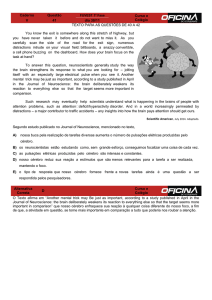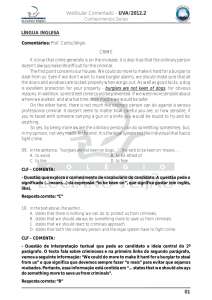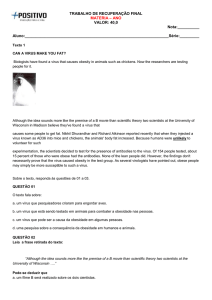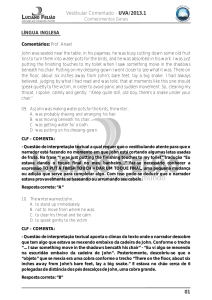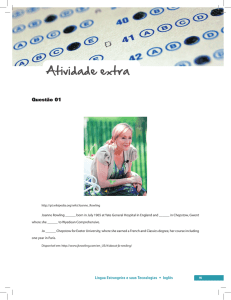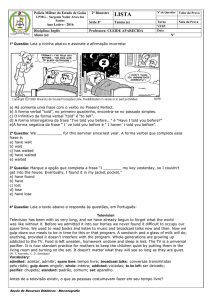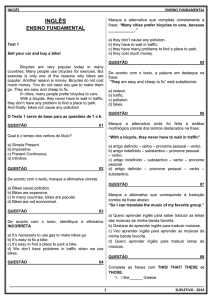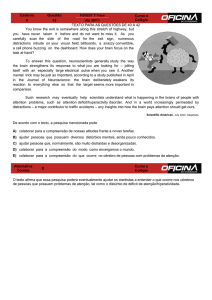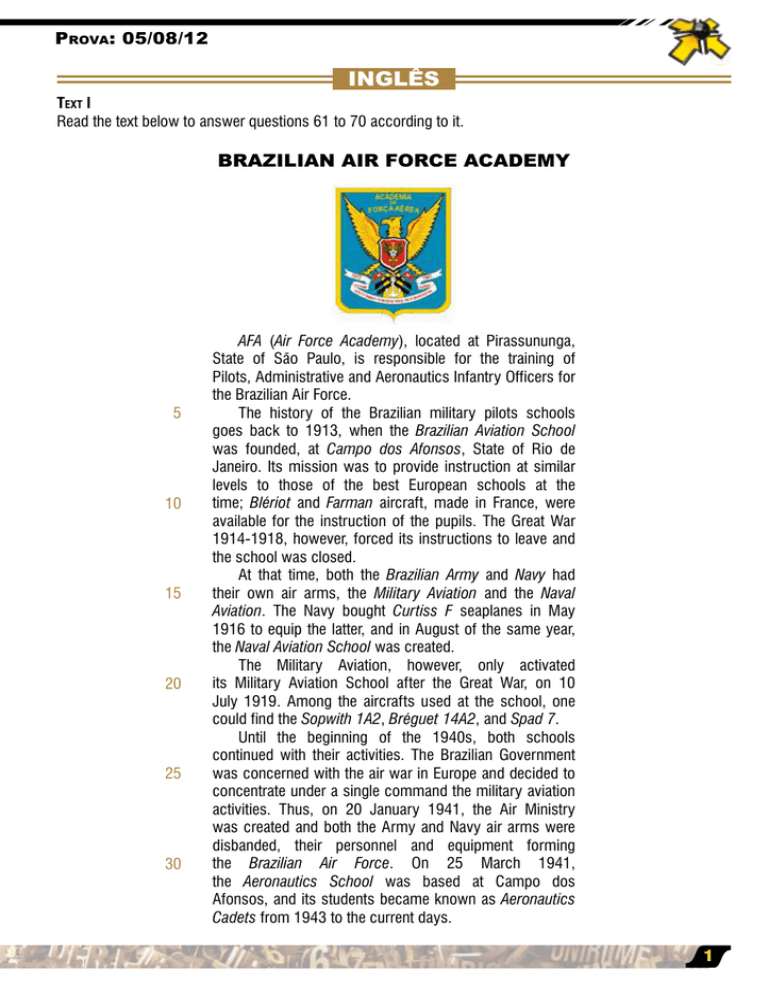
Prova: 05/08/12
Inglês
Text I
Read the text below to answer questions 61 to 70 according to it.
Brazilian Air Force Academy
5
10
15
20
25
30
AFA (Air Force Academy), located at Pirassununga,
State of São Paulo, is responsible for the training of
Pilots, Administrative and Aeronautics Infantry Officers for
the Brazilian Air Force.
The history of the Brazilian military pilots schools
goes back to 1913, when the Brazilian Aviation School
was founded, at Campo dos Afonsos, State of Rio de
Janeiro. Its mission was to provide instruction at similar
levels to those of the best European schools at the
time; Blériot and Farman aircraft, made in France, were
available for the instruction of the pupils. The Great War
1914-1918, however, forced its instructions to leave and
the school was closed.
At that time, both the Brazilian Army and Navy had
their own air arms, the Military Aviation and the Naval
Aviation. The Navy bought Curtiss F seaplanes in May
1916 to equip the latter, and in August of the same year,
the Naval Aviation School was created.
The Military Aviation, however, only activated
its Military Aviation School after the Great War, on 10
July 1919. Among the aircrafts used at the school, one
could find the Sopwith 1A2, Bréguet 14A2, and Spad 7.
Until the beginning of the 1940s, both schools
continued with their activities. The Brazilian Government
was concerned with the air war in Europe and decided to
concentrate under a single command the military aviation
activities. Thus, on 20 January 1941, the Air Ministry
was created and both the Army and Navy air arms were
disbanded, their personnel and equipment forming
the Brazilian Air Force. On 25 March 1941,
the Aeronautics School was based at Campo dos
Afonsos, and its students became known as Aeronautics
Cadets from 1943 to the current days.
1
Gabarito AFA
35
40
45
50
55
As early as 1942, it became clear that
the Aeronautics School would need to be transferred
to another place, offering better climate and little
interference with the flight instruction of the future pilots.
The town of Pirassununga was chosen among
others, and, in 1952, the first buildings construction
was iniciated. The transfer of the School activities to
Pirassununga ocurred from 1960 to 1971. The School
was redesigned as the Air Force Academy in 1969.
The motto of the Academy is the Latin expression
“Macte Animo! Generose Puer, sic itur ad astra”,
extracted from the poem Thebaida, by the Roman poet
Tatius. It is an exhortation to the cadets, which can
be translated as Courage! This is the way, oh noble
youngster, to the stars.
The instruction of the Aeronautics Cadets, during
the four-year-long course, has its activities centred in
the words COURAGE – LOYALTY – HONOUR – DUTY
– MOTHERLAND. The future officers take courses on
several subjects, including Calculus, Computer Science,
Mechanics, Portuguese and English, given by civilian
lecturers, Air Force instructors and supervisors. The
military instruction itseld is given on a daily basis, and
the Cadets are trained on different subjects, including
parachuting, and sea and jungle survival.
Flight instruction at the Academy wih T-27 Tucano aircraft.
60
65
2
According to the chosen specialization, the Cadet will
receive specific instruction:
Pilots: Instruction on precision maneuvering, aerobatics,
formation flying and by instruments, with 75 flying hours
on the primary/basic training aircraft T-25 Universal,
beginning on the 2nd term of the 1st year and completed
in the 3rd year. Advanced training is given on T-27
Tucano aircraft, with 125 flying hours.
Prova: 05/08/12
70
75
80
Administrative: Training on the scientific and
technological modern foundations of economics and
financial management, and logistics training.
Aeronautics Infantry: Instruction on defense and
security techniques of military Aeronautics installations,
anti-aircraft measures, command of troops and firefighting teams, military laws and regulations, armament
usage, military service and call-up procedures.
During their leisure time, the Cadets participate on
the activities of seven different clubs: Aeromodelling,
Literature, Informatics, Firearms shooting, Gauchos
Heritage (for those coming from the South of Brazil),
Gerais Club and Sail Flying. The clubs are directed by
the Cadets themselves, under supervision of Air Force
officers.
The Academy also houses the Brazilian Air Force Air
Demonstration Squadron – The Smoke Squadron.
Flying as the eagles do!
(Adapted from http://www.rudnei.cunha.nom.br/FAB/en/afa.html)
Questão 61
Mark the option that is related to the Air Force Academy.
(A) Cadets are prepared at AFA to perform in different areas.
(B) The Air Force Academy trains the Army to administer the Brazilian officers.
(C) The Academy instructs the Aeronautics Brazilian officers to manage our country.
(D) The Brazilian Aviation School forced AFA’s instructors to abandon their military base creating a new
command.
Gabarito: Letra A.
Questão de compreensão de texto.
O trecho que compreende as linhas 56-58 é o suporte material para a resposta dessa questão. Ele afirma que
os cadetes são treinado em diferentes atividades, ou áreas.
Questão 62
Read the statements in order to mark only the correct ones according to the text.
I.
II.
III.
IV.
The military aviation work had to be controlled by Europe in the beginning of the 1940s because of a war.
Because of a war, the government resolved to unify the military aviation operation under a single command.
A single officer was chosen to concentrate the military aviation skills.
As the Brazilian got worried, it was decided to join the military aviation operations due to air European war.
(A) III and I.
(B) II and IV.
(C) I, II and III.
(D) II, III and IV.
3
Gabarito AFA
Gabarito: Letra B.
Questão de compreensão de texto.
I. Errada. O Texto não corrobora o entendimento de que a atividade de aviação militar tivesse de ser
transferida para a Europa por causa da guerra.
II. Correta.
III. Errada. O texto afirma (l. 24-27) que o governo brasileiro decidiu concentrar sob um único comando as
atividades de aviação militar.
IV. Correta.
Questão 63
The last sentence from the text connotes a:
(A) way to celebrate the importance of The Brazilian mulitary schools.
(B) methaphor that describes the similarity among pilots, aircrafts and wings.
(C) comparison between a myth and a hero.
(D) reference to ancient airplanes.
Gabarito: Letra B.
Questão de compreensão textual localizada.
A sentença “Flying as the eagles do!” realmente estabelece e estimula a concepção da semelhança entre
pilotos e suas aeronaves e as águias, simbolo de realeza e domínio dos ares. Ressaltamos, no entanto, que,
havendo a palavra “as” para estabelecer a comparação entre pilotos e águias, aproximamo-nos mais de uma
símile do que uma metáfora.
Resposta certa: B.
Questão 64
Mark the alternative that has the fragment from the text INCORRECTLY changed info Active Voice.
(A) The air war in Europe concerned The Brazilian Government. (lines 24,25)
(B) Someone chose the town of Pirassununga among others. (lines 38,39)
(C) Somebody redesigned the School as the Air Force Academy. (lines 41, 42)
(D) The officers trained the Cadets on different subjects. (lines 56, 57)
Gabarito: Letra D.
Questão que explora o conteúdo gramatical de vozes ativa e passiva.
A opção D afirma que os oficiais treinaram os cadetes. Texto, no entanto, não menciona quem é o agente da
passiva, elemento essencial para determinar o suposto sujeito “oficiais” da voz ativa.
4
Prova: 05/08/12
Questão 65
We can infer from the text that among the different specializations:
(A) the future Pilot has to be trained for hours before becoming skilful.
(B) the pilot should follow instructions on security techniques and deal with anti-aircraft measures more than
the Aeronautics Infantry.
(C) the Administrative Officer might have the most advanced training on aircraft of all.
(D) Aeronautics Infantry and Pilots ought to obtain more and more instructions on aerobatics.
Gabarito: Letra A.
Questão de interpretação localizada.
No trecho (. 61-66) referente ao treinamento específico do piloto, lemos que ele [treinamento] compreende,
no total, 200 horas de voo, ao longo de 2 anos de estudos. Conclui-se, portanto, que esse período de
treinamento tornará o candidato habilidoso.
Questão 66
All the options below complete the boldfaced sentence. Mark the one in wwhich the Relative Pronoun is
INCORRECTLY used.
When Brazilian Aviation School was founded,
(A) both the Brazilian Army and the Navy, which had their own air arms, used to have military missions.
(B) Rio de Janeiro was the place where this school was located.
(C) there were two French aircrafts who were available to the instructions of the students.
(D) it provided instructions that were similar to the best European schools.
Gabarito: Letra C.
Questão gramatical que trata de Pronome Relativo.
O Pronome Relativo who refere-se somente a pessoas. Aircrafts “aeronaves” são objetos; logo, o pronome
não poderia ser usado.
Questão 67
Read the statements about the informative text and mark the correct option.
I. In the beginning of the last century, Brazilian cadets were sent to the best Europen schools that provided
them instruction.
II. In France, the youngsters had Blériot and Farman aircraft instruction.
III. Brazilian Aviation School had to be closed in 1913.
IV. The Brazilian Aviations School and the Naval Aviations School were created in the same year.
(A) Only I and II are correct.
(B) Only III and IV are correct.
(C) All sentences are correct.
(D) None of the sentences are correct.
5
Gabarito AFA
Gabarito: Letra D.
O candidato deveria avaliar se as afirmativas I, II, III e IV dadas estavam em consonância com o texto
informativo.
I. Os cadetes Brasileiros não eram mandados para as melhores escolas européias.
II. Os jovens matriculados na “Brazilian Aviation School” tinham aulas com as aeronaves Blériot e Farman.
Esta escola localizava-se no Brasil, não na França.
III. O texto não menciona o fechamento da escola de Aviação Brasileira.
IV. O texto menciona a criação da “Brazilian Aviation School” em 1913, mas não fala sobre a data da criação
da “Naval Aviation School”.
Questão 68
The connectives however (line 19) and thus (line 27) express, respectively ____________ and _________.
(A) contrast – result
(B) addition – conclusion
(C) contrast – addition
(D) conclusion – result
Gabarito: Letra A.
Questão gramatical que trata de conectores.
→ however é um conector que sempre expressa contrate e significa porém.
→ Thus é um conector que sempre expressa resultado e signifca consequentemente.
Questão 69
According to the text, in 1941:
(A) the Brazilian Air Force replaced the Army and Navy air arms.
(B) Military and Naval aviation schools were created at Campo dos Afonsos.
(C) students from both Military and Naval aviation schools started to be called Aeronautics Cadets.
(D) the Air Ministry created the Army and Navy air arms.
Gabarito: Letra A.
Questão interpretativa de foco.
De acordo com o texto, o aluno deveria marcar a opção que demonstra o que aconteceu em 1941.
Houve a dissolução das “The Army and the Navy air arms” e a criação da “The Brazilian Air Force”.
Linha 27. Thus, on 20 January 1941.
Questão 70
The sentence “The Military Aviation [...] activated its Military Aviation School after the Great War [...]” can be
rewritten, with the same meaning, as _________.
6
Prova: 05/08/12
(A) during the Great War the Military Aviation activated its Military Aviation School.
(B) by the time the Military Aviation activated its Military Aviation School, the Great War had already finished.
(C) the Great War finished when the Military Aviation activated its Military Aviation School.
(D) the Military Aviation activated its Military Aviation School through the Great War.
Gabarito: Letra B.
O aluno tinha de identificar a frase com sentido análogo à dada.
A chave é a palavra “after”, que mostra claramente que a “Military Aviation School” foi criada pela “Military
Aviation” apenas depois da 1a Guerra Mundial.
Esta alternativa traz perfeitamente essa sequência de fatos usando a estrutura “By the time + past simple +
past + perfect” nas orações.
Text II
Why Bilinguals Are Smarter
5
10
15
20
25
Speaking two languages rather than just one has
obvious practical benefits in an increasingly globalized
world. But in recent years, scientists have begun to show
that the advantages of bilingualism are even more
fundamental than being able to converse with a wider
range of people. Being bilingual, it turns out, makes you
smarter. It can have a profound effect on your brain,
improving cognitive skills not related to language and
even protecting from dementia in old age.
This view of bilingualism is remarkably different
from the understanding of bilingualism through much of
the 20th century. Researchers, educators and policy
makers long considered a second language to be an
interference, cognitively speaking, that delayed a child’s
academic and intellectual development. They were not
wrong about the interference: there is ample evidence
that in a bilingual’s brain both language systems are
active even when he is using only one language, thus
creating situations in which one system obstructs the
other. But this interference, researchers are finding out,
isn’t so much a handicap as a blessing in disguise. It
forces the brain to resolve internal conflict, giving the mind
a workout that strengthens its cognitive muscles.
Bilinguals, for instance, seem to be more adept
than monolinguals at solving certain kinds of mental
puzzles. In a 2004 study by the psychologists Ellen
Bialystok and Michelle Martin-Rhee, bilingual and
monolingual preschoolers were asked to sort blue circles
7
Gabarito AFA
30
35
40
45
50
55
60
65
70
75
8
and red squares presented on a computer screen into
two digital bins — one marked with a blue square and
the other marked with a red circle. In the first task, the
children had to sort the shapes by color, placing blue
circles in the bin marked with the blue square and red
squares in the bin marked with the red circle. Both
groups did this with comparable ease. Next, the
children were asked to sort by shape, which was more
challenging because it required placing the images in a
bin marked with a conflicting color. The bilinguals were
quicker at performing this task.
The collective evidence from a number of such
studies suggests that the bilingual experience improves
the brain’s so-called executive function — a command
system that directs the attention processes that we use
for planning, solving problems and performing various
other mentally demanding tasks. These processes
include ignoring distractions to stay focused, switching
attention willfully from one thing to another and holding
information in mind — like remembering a sequence of
directions while driving.
Why does the tussle between two simultaneously
active language systems improve these aspects of
cognition? Until recently, researchers thought the
bilingual advantage stemmed primarily from an ability
for inhibition that was improved by the exercise of
suppressing one language system: this suppression, it
was thought, would help train the bilingual mind to ignore
distractions in other contexts. But that explanation
increasingly appears to be inadequate, since studies
have shown that bilinguals perform better than
monolinguals even at tasks that do not require inhibition,
like threading a line through an ascending series of
numbers scattered randomly on a page.
The bilingual experience appears to influence the
brain from infancy to old age (and there is reason to
believe that it may also apply to those who learn a
second language later in life).
In a 2009 study led by Agnes Kovacs of the
International School for Advanced Studies in Trieste,
Italy, 7-month-old babies exposed to two languages
from birth were compared with peers raised with one
language. In an initial set of trials, the infants were
presented with an audio cue and then shown a
puppet on one side of a screen. Both infant groups
learned to look at that side of the screen in anticipation
of the puppet. But in a later set of tests, when the puppet
Prova: 05/08/12
80
85
90
began appearing on the opposite side of the screen,
the babies exposed to a bilingual environment quickly
learned to switch their anticipatory gaze in the new
direction while the other babies did not.
Bilingualism’s effects also extend into the twilight
years. In a recent study of 44 elderly Spanish-English
bilinguals, scientists led by the neuropsychologist Tamar
Gollan of the University of California, San Diego, found
that individuals with a higher degree of bilingualism
— measured through a comparative evaluation of
proficiency in each language — were more resistant than
others to the beginning of dementia and other symptoms
of Alzheimer’s disease: the higher the degree of
bilingualism, the later the age of occurrence.
Nobody ever doubted the power of language. But
who would have imagined that the words we hear and
the sentences we speak might be leaving such a deep
imprint?
(Adapted from http://www.nytimes.com/2012/03/18/opinion/sunday/the-benefits-of-bilingualism.html)
Questão 71
The last two sentences of the second paragraph mean that the interference of bilingualism:
(A) was considered positive in the past, but nowadays this view has changed.
(B) has always been a problem, since the brain has to solve an internal conflict.
(C) brings to the brain an internal conflict that improves its congnition.
(D) has proved to increase the disabilities of the brain and reduce the blessings it can have.
Gabarito: Letra C.
Questão interpretativa em que o candidato deve atentar somente para as duas últimas frases do segundo
parágrafo. De acordo com a análise deste trecho do texto, podemos inferir que a interferência do bilinguismo
gera um conflito interno para o cérebro, o que desenvolve ainda mais o campo cognitivo.
Alternativa correta é a opção C.
Questão 72
Considering the context, mark the alternative that contain the correct synonym or explanation to the words
from the text.
(A) Remarkably (line 10) – ordinarily, usually.
(B) For instance (line 24) – in my opinion.
(C) So-called (line 42) – used to introduce a new expression.
(D) Even (line 60) – used to explain something.
9
Gabarito AFA
Gabarito: Letra C.
Questão de vocabulário com interpretação.
Considerando a explicação da expressão “so-called” e seu emprego sugerido, verificamos que realmente
está sendo utilizada para introduzir uma nova expressão – “ executive function”. Alternativa correta é a
opção C.
Questão 73
Mark the INCORRECT option. According to the text, recent researches prove that bilingualism:
(A) causes general cognitive development.
(B) enables people to communicate better in both languages only.
(C) prevents people from suffering from problems related to memory and other mental disorders or delay
these problems.
(D) is seen as positive cognitive interference.
Gabarito: Letra B.
Pois de acordo com o texto, pesquisas recentes comprovam que o bilinquismo não capacita as pessoas
somente na comunicação de dois idiomas.
Questão 74
Mark the option that correctly substitutes the expression rather than (line 01)
(A) Instead of.
(B) As well as.
(C) Aside from.
(D) In addition to.
Gabarito: Letra A.
Questão gramatical que exige que o candidato saiba que o marcador de discusivo “RATHER” “THAN” pode
ser substituido por “instead of” as demais são conjunções de adição. Alternativa correta é a opção A.
Questão 75
Based on the text, it is NOT correct to state that bilingualism:
(A) delays the symptoms of diseases related to old age.
(B) has effect on children’s brains.
(C) is irrelevant for the elderly.
(D) develops the ability if performing difficult tasks
Gabarito: Letra C.
De acordo com o texto, não é correto afirmar que o bilinguismo é irrelevante para os idosos. O texto afirma
no penúltimo parágrafo que o bilinguismo é favorável para os idosos.
10
Prova: 05/08/12
Questão 76
The psychological study done in 2004 (3rd paragraph) showed that:
(A) the children in prechool had the same performances in both test.
(B) bilingual children were more efficient in the most complex test.
(C) monolinguals are better at solving mental puzzles.
(D) blue and red are confusing colors for both groups.
Gabarito: Letra B.
Referente à compreensão textual.
A resposta está no 3o parágrafo, da linha 35 a 39. Observe que a expressão comparativa de superioridade
referente à tarefa mais complexa (more challenging) nos remete à opção correta letra B: “Bilingual children
were more efficient in the most complex task.”
Questão 77
The relative pronoun THAT can be omitted in all the sentences below, EXCEPT:
(A) The collective evidence from a number of such studies suggests that the bilingual experience improves
the brain’s so-called executive function. (lines 40–43.
(B) [...] the bilingual advantage was centered primarily in ability for inhibition that was improved by the
exercise of suppressing one language system. (lines 52–55)
(C) [...] there is reason to believe that it may also apply to those who learn a second language later in life.
(lines 64–66)[...]
(D) But who would have imagined that the words we hear and the sentences we speak might be leaving such
a deep imprint? (lines 90–93).
Gabarito: Letra B.
Referente ao uso gramatical.
Observe que o pronome relativo That é sujeito da frase na alternativa B. Pela norma gramatical da Língua
Inbglesa o pronome relativo não pode ser omitido quando for sujeito da frase, o que acontece na opção B.
Questão 78
One extracted fragment has its correct Tag Question. Mark the item.
(A) The bilingual experience appears to influence the brain from infancy to old age, don’t they?
(B) Bilingualism’s effects also extend into the twilight years, has it?
(C) These processes include ignoring distractions to stay focused, aren’t they?
(D) Nobody ever doubted the power of language, did they?
Gabarito: Letra D.
Questão referente ao uso correto da gramática no conteúdo tag-question.
A opção A está incorreta pois a tag question deveria ser: doesn’t it? A opção B está incorreta pois a tag-question deveria ser: don’t they? A alternativa C está incorreta, pois a tag question deveria ser: don’t they?
11
Gabarito AFA
Questão 79
Considering the use of comparison, mark the INCORRECT option:
(A) [...] the advanteges of bilingualism are even more fundamental than being able to converse [...] (lines 4-5)
(B) [...] with a wider range of people (lines 5-6)
(C) [...] the understanding of bilingualism through much of the 20th centery. (lines 11-12)
(D) The bilinguals were quicker at performing this task. (lines 38-39)
Gabarito: Letra C.
Referente ao uso gramatical.
Considerando o enunciado da questão, pedindo o uso incorreto do grau comparativo, a única opção a não
empregar grau comparativo é a letra C. As demais alternativas estão de acordo com as regras.
Questão 80
In the question “Why does the fight between two simultaneously active language systems improve these
aspects of cognition?” (lines 50 – 53) the author asked:
(A) if the fight between two simultaneously active language systems had improved these aspects of cognition.
(B) why does the fight between two simultaneously active language systems improved those aspects of
cognition?”
(C) why the fight between two simultaneously active language systems improved those aspects of cognition.
(D) if the fight between two simultaneously active language systems improve these aspects of cognition?”
Gabarito: Letra C.
A questão aborda o assunto reported speech no que tange uma pergunta.
Quando usamos o reported speech, em perguntas com wh no direct speech, a fazemos da seguinte forma:
wh-question seguida de sujeito + (verbo auxiliar) + verbo principal, ou seja. perde-se a forma de perguntar.
Conclusão
A prova de 2012/2013 apresenta um padrão relativamente diferente dos anos anteriores com
somente dois textos longos.
Os textos foram explorados, principalmente, no âmbito interpretativo, com questões gramaticais
que englobam assuntos como: vozes ativa e passiva, pronome relativo, conjunção, discursos direto
e indireto, forma comparativa, estrutura verbal e tag-questions.
Em síntese, os textos longos proporcionam um desgaste no candidato exigindo assim técnicas
de leitura de varredura de texto. As questões gramaticais, diretas, não exigem a convergência de
outros conteúdos gramaticais.
Professores
Elaine Marques
Pedro Savelli
Marcelo Afonso
Robson Quirino
12


